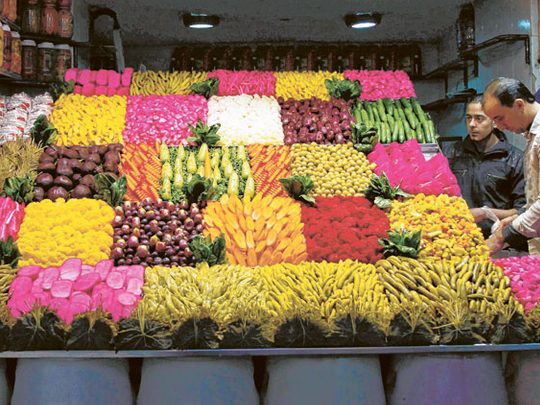
Dubai: More than a billion people across the world who survive on less than $1.25 a day will feel the impact of higher food prices as developing-nation governments struggle to feed their poor.
Prices of grains, sugar, meat and other edibles are at an all-time high, according to the United Nations' Food and Agriculture Organisation (FAO) food price index for December, released on Wednesday.
The index, which measures monthly price changes for a food basket composed of cereals, oilseeds, dairy, meat and sugar, averaged 215 points last month, up from 206 points in November.
While prices did decline after 2008, they remained substantially higher than prior to the price surge, and they are likely to remain at 2010 levels or higher for the next decade, according to the International Fund for Agricultural Development (IFAD).
"In the short term, supply is likely to run ahead of demand and that's going to squeeze stocks. The likelihood is that prices will remain high and possibly rise further," Edward Heinemann, lead author of IFAD's Rural Poverty Report, told Gulf News.
"The immediate prospects are of some concern."
Several factors are feeding into the global increase in food prices. Climate change is of long-term concern. Speculation in edible commodities is an immediate and clear danger as feeds volatility in the prices of agricultural produce.
And a growing demand for biofuels is prompting a shift in agricultural production trends.
"It looks likely that global food security and climate change will be among the key issues of the 21st century," said IFAD president Kanayo F. Nwanze.
To date, much of the production response to higher prices has come from rich countries. Looking to the future, however, it is calculated that feeding a global population of just over nine billion in 2050 will require a 70 per cent increase in global food production, while ensuring food security for all will demand that issues of access and affordability are also addressed.
This will require that agriculture — particularly smallholder agriculture — play a much more effective role in these countries, and that greater and more effective efforts are made to address the concerns of poor rural people as food buyers, according to the poverty report.
"The food price issue is a symptom of a larger issue. Agricultural production is changing, rural areas are changing, agricultural markets are changing," Heinemann said.
"All that is happening in the context of growing risk for farmers, particularly the small farmers in the developing countries. Climate change is making everything more uncertain."
Shifts in the climatic patterns are making it more difficult for farmers to plan and for countries to accurately assess their likely production levels or requirements.
"We are seeing a new era of uncertainty, which is going to be problematic for farmers and for governments," Heinemann said.
During the food price crisis of 2008, a series of factors contributed to making it a global crisis.
"I suspect that future crises are more likely to be more localised and more specific and the overall global crisis will be rare," Heinemann said.
Food prices are a function of demand, supply and the levels of stock in each nation that provide the buffer between the two.
Demand is likely to continue to increase at about two per cent per year, according to IFAD.
"What we saw in 2008 is that once prices start to rise, a whole series of other factors come into play. These include trade restrictions, speculation — those can exacerbate the price increases," Heinemann said.
"The other thing we saw in the 2008 crisis was that oil prices had a tremendously important transmission effect into food prices.
So, much also depends on the price of fuel," Heinemann said.
Prices of crude are flirting with the $100-a-barrel level (Dh367) as economic growth rebounds globally and demand for fuels increases correspondingly.
"What remains critical is investment in the agricultural sector — in production, in marketing, in the infrastructure that makes these possible," Heinemann said.
"That may not resolve food issues overnight, but that is the surest solution in the medium and long term.
"We've seen that countries that have invested in the agricultural sector have reduced poverty and hunger and spurred economic growth as a whole."
Ensuring that food markets work is going to be "an ever more important responsibility" for developing-nation governments in the years to come, Heinemann said.
People to be empowered
The International Fund for Agricultural Development has highlighted four key issues that it said would further an agenda for rural economic growth and add to future food security.
First, it is essential to improve the overall environment of rural areas, including infrastructure, utilities, services and governance. Second, it is vital to enable poor rural people to manage risk and to reduce the level of risk they face.
Third, it is fundamental to invest in education to enable women, men, young people and children to develop the skills they need to take advantage of new economic opportunities.
And fourth, there is an ongoing need to strengthen the collective capabilities of rural people, particularly through their membership organisations. "These organisations give people confidence, security and power — all invaluable attributes for overcoming poverty," the Rural Poverty Report 2011 says.












